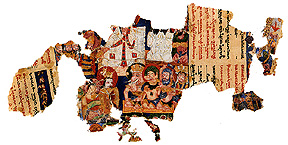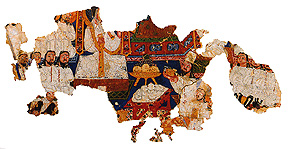

8th -9th century
Khocho
Ink and polychrome on paper
12.4 x 25.5 cm
Acquisition number: MIK III 4979
Image courtesy of the Museum für Indische Kunst (copyright reserved)
Staatliche Museen zu Berlin - Preussischer Kulturbesitz
Illustrated here are the two sides of the largest fragment from a Manichaean illustrated manuscript in the collection of the Museum für Indische Kunst in Berlin. On one side is depicted what appears to be a reception for by an unidentified figure in the center. Damage to the manuscript has destroyed this figure's head., though the larger stature of this individual compared to other figures on the page (including the deities seated below), verifying his importance, and possibly his divinity. The figure grasps the hand of a man in golden armor, perhaps a ruler.
Sitting below this large figure are two rows of deities. Two Manichaean gods line up on one side, and with Hindu gods lined up on the other (from the left: Ganesha, Varaha, Brahma (?), and Shiva). The implication of this meeting between deities of differing faiths is not known. The fact that the Hindu divinities all seem to bear objects (gifts?), while the Manichaean deities do not, may be significant.
On the reverse side of the page is a depiction of an important religious feast commemorating the martydom of Mani, the founder of the Manichaean faith. Various fruits and other foods have been offered for the ceremony, including loaves of bread in the shape of the sun and the crescent moon.1
The identity of the central figure on this page is not known, though his large size, and the presence of a halo emphasizes his importance; this may be a depiction of Mani himself. Some of the electors have their names written on their garments, identifying the more important members of the assembly.
(1) Along the Ancient Silk Routes: Central Asian Art from the West Berlin State Museums (New York: The Metropolitan Museum of Art), pp. 176-7.